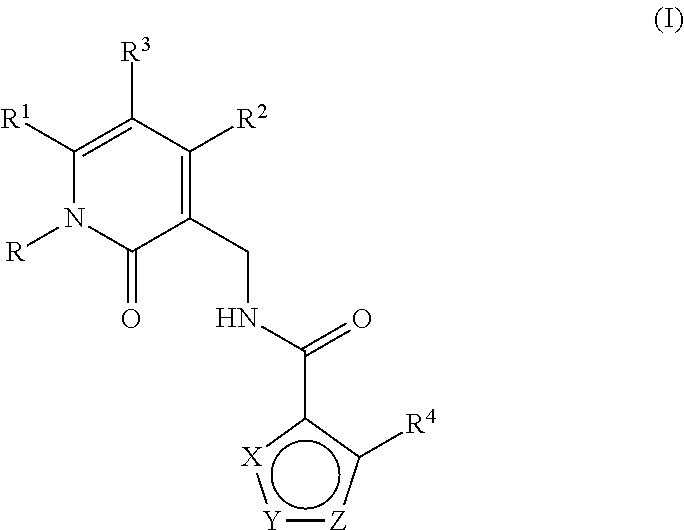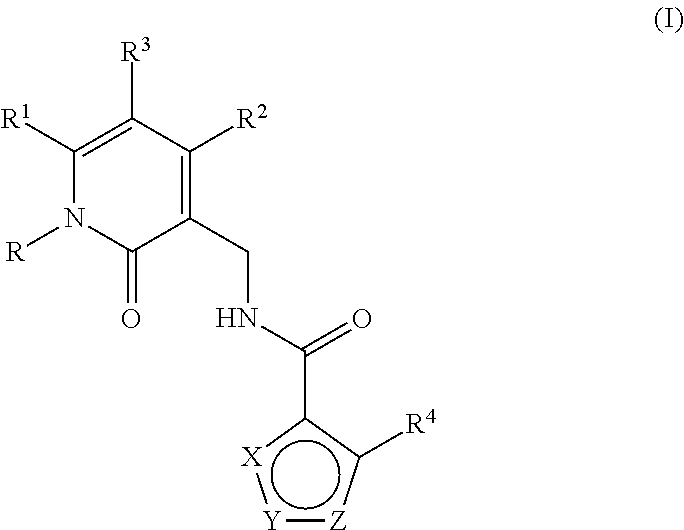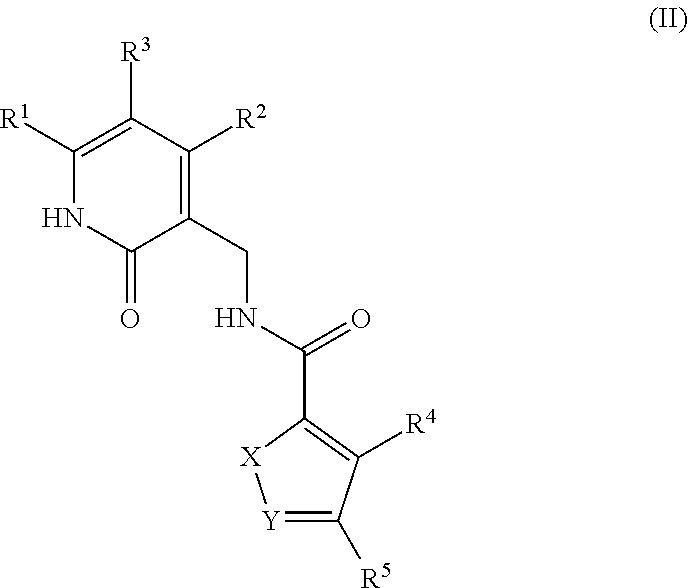Enhancer of zeste homolog 2 inhibitors
a zeste homolog 2 inhibitor and zeste technology, applied in the field of compounds, can solve the problems of increased metastasis, shorter disease-free survival, and increased risk of recurren
- Summary
- Abstract
- Description
- Claims
- Application Information
AI Technical Summary
Benefits of technology
Problems solved by technology
Method used
Image
Examples
example 1
N-((4,6-dimethyl-2-oxo-1,2-dihydropyridin-3-yl)methyl)-4-isopropoxy-3-methylthiophene-2-carboxamide
[0429]
[0430]To a cooled (ice bath) solution of isopropyl alcohol (3.49 mL, 45.2 mmol) and DMF (20 mL) was added 60% NaH (1.809 g, 45.2 mmol) in portions. The mixture was stirred for 15 min, at which time the ice bath was removed. The reaction was stirred at RT overnight, at which time 4-bromo-3-methylthiophene-2-carboxylic acid (1.0 g, 4.52 mmol) and CuBr (0.162 g, 1.131 mmol) were added. The reaction was stirred well for 5 min, then heated at 120° C. overnight. The reaction was allowed to cool to RT and was poured into ice / saturated NH4Cl. The mixture was extracted with EtOAc (3×) and the combined organics were dried over MgSO4, filtered through Celite®, and concentrated to give crude 4-isopropoxy-3-methylthiophene-2-carboxylic acid as a solid.
[0431]To a mixture of the crude 4-isopropoxy-3-methylthiophene-2-carboxylic acid, 3-(aminomethyl)-4,6-dimethyl-2(1H)-pyridinone hydrochloride (...
example 2
N-((4,6-Dimethyl-2-oxo-1,2-dihydropyridin-3-yl)methyl)-4-(ethyl(tetrahydro-2H-pyran-4-yl)amino)-3-methylthiophene-2-carboxamide
[0432]
a) Methyl 4-bromo-3-methylthiophene-2-carboxylate
[0433]
[0434]To a solution of 4-bromo-3-mehylthiophene-2-carboxylic acid (5.0 g, 22.62 mmol) in MeOH (75 mL) was added dropwise H2SO4 (6.03 mL, 113 mmol). The mixture was heated at 60° C. for 12 h. The reaction was allowed to cool to RT and was diluted with EtOAc and 1 N HCl. The organic layer was concentrated and the residue was precipitated from MeOH / water (9 / 1). The white solid was dried under vacuum to give methyl 4-bromo-3-methylthiophene-2-carboxylate (4.5 g, 76%). 1H NMR (400 MHz, DMSO-d6) δ 8.06 (s, 1H) 3.83 (s, 3H) 2.47 (s, 3H). MS(ES) [M+H]+ 236.8.
b) Methyl 4-amino-3-methylthiophene-2-carboxylate
[0435]
[0436]To a 20 mL microwave vial was added methyl 4-bromo-3-methylthiophene-2-carboxylate (2.0 g, 8.51 mmol), Cs2CO3 (5.54 g, 17.01 mmol), benzophenone imine (2.141 mL, 12.76 mmol), 1,4-dioxane (7 m...
example 3
5-Chloro-N-((4,6-dimethyl-2-oxo-1,2-dihydropyridin-3-yl)methyl)-4-(ethyl(tetrahydro-2H-pyran-4-yl)amino)-3-methylthiophene-2-carboxamide
[0443]
a) Methyl 5-chloro-4-(ethyl(tetrahydro-2H-pyran-4-yl)amino)-3-methylthiophene-2-carboxylate
[0444]
[0445]To a solution of methyl 4-(ethyl(tetrahydro-2H-pyran-4-yl)amino)-3-methylthiophene-2-carboxylate (500 mg, 1.764 mmol) in CH3CN (10 mL) was added NCS (353 mg, 2.65 mmol). The mixture was stirred at RT for 24 h, at which time it was quenched with 10% Na2S2O3 and extracted with EtOAc. Purification by silica gel chromatography (Varian 971, 0-20% EtOAc / hexanes, SF25-40 g, 9 min) provided methyl 5-chloro-4-(ethyl(tetrahydro-2H-pyran-4-yl)amino)-3-methylthiophene-2-carboxylate (350 mg, 59.3%) as an oil. 1H NMR (400 MHz, CDCl3-d) δ 3.96 (br. s., 2H) 3.87 (s, 3H) 3.31-3.45 (m, 4H) 3.02-3.24 (m, 1H) 2.43 (s, 3H) 1.43-1.87 (m, 4H) 0.94 (t, 3H). MS(ES) [M+H]+ 318.0.
b) 5-Chloro-N-((4,6-dimethyl-2-oxo-1,2-dihydropyridin-3-yl)methyl)-4-(ethyl(tetrahydro-2H-...
PUM
| Property | Measurement | Unit |
|---|---|---|
| weight | aaaaa | aaaaa |
| weight | aaaaa | aaaaa |
| weight | aaaaa | aaaaa |
Abstract
Description
Claims
Application Information
 Login to View More
Login to View More - R&D
- Intellectual Property
- Life Sciences
- Materials
- Tech Scout
- Unparalleled Data Quality
- Higher Quality Content
- 60% Fewer Hallucinations
Browse by: Latest US Patents, China's latest patents, Technical Efficacy Thesaurus, Application Domain, Technology Topic, Popular Technical Reports.
© 2025 PatSnap. All rights reserved.Legal|Privacy policy|Modern Slavery Act Transparency Statement|Sitemap|About US| Contact US: help@patsnap.com



